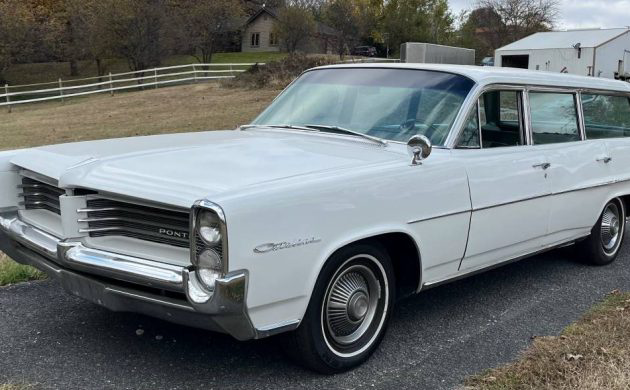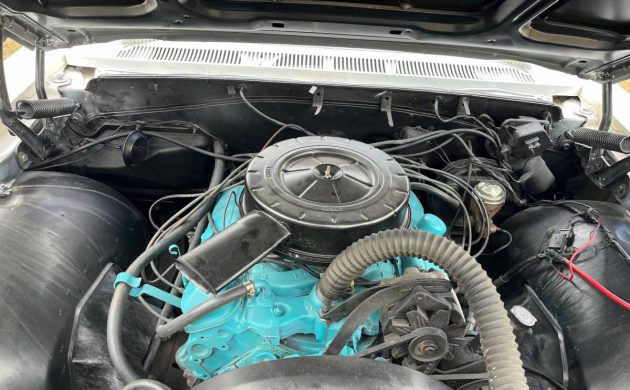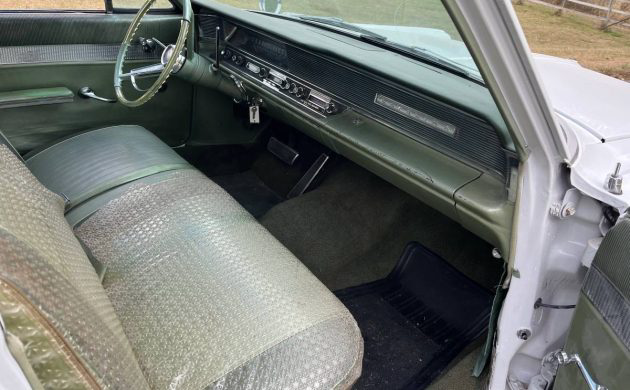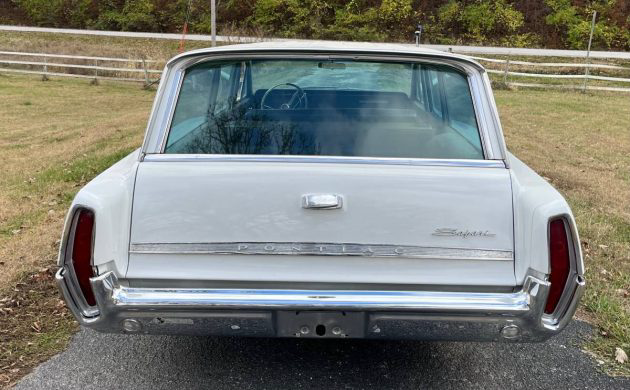Pontiac adopted the term “Safari” to denote its wagon line starting in 1955. Originally a counterpoint to Chevrolet’s Nomad, it was introduced in a two-door body style. Comparing base models across Pontiac’s range, the Safari was the division’s most expensive car. That restrained production to under 4000 copies in its first year. This pattern persisted, with the high-priced Safari trickling out of Pontiac’s factories, while its competitors (the Nomad, the Handyman) outsold it by thousands. In 1959, buyers could opt for a Catalina Safari or the larger Bonneville Safari; sales finally picked up as four-door wagons became ubiquitous. Today’s example sits on the slightly smaller Catalina wheelbase, and it’s advertised here on craigslist for $15,900. The car is being sold “for a friend” and it’s located in Glenwood, Iowa. Thanks once again to T.J. for another outstanding tip! This Safari has had a recent repaint, but I’m suspicious of the style crease above the sills. It wavers and doesn’t mate up across panels; I’d want to run a magnet along its flanks. The leading edge of the driver’s door is gapped, too. (Am I just in a picky mood?) This example, also in white, has a crisper appearance. Pontiac’s stacked headlamps appeared in 1963 while that split grille lasted well into the 1970s.
Meanwhile, in the power department, Pontiac dished up a few flavors of its 389 cu. in. V8 depending on which model and which transmission a buyer chose. The “Trophy 8” engine in the Safari made 267 hp, and came equipped with a two-barrel Rochester and a Hydra-Matic automatic. This engine has been rebuilt and the car is said to run and drive well. Starting in 1959 and continuing for years after, Pontiac widened its chassis to put the wheels of its cars farther apart than its competitors, selling the idea on the basis of stability. But “wide track” cars also looked more aggressive and seemed to sit lower, surfing the marketing trend of “lower, longer, wider”. Power steering and power brakes round out the mechanicals, and the wagon rides on new tires.
The interior retains a few charming vintage features – the steering wheel has translucent segments, the lock for the glovebox sits on its horizontal surface, the seats are in great shape under the plastic covers. But the dash was redesigned in 1960 and grew more sedate from then on, with less distinctive gauges, rather like the exterior.
Unlike the front of the Safari, which screams “Pontiac”, the rear is less remarkable. The Catalina wagon offered two- or three-row seating, and an optional power rear window. Under the pretext of “modernization” – nearly always the excuse for a shift in styling – the squared-up styling lasted into the late 1960s, when the “coke bottle” silhouette took over. The Safari name persisted into the 1980s, often incorporating faux wood trim. Today, Catalina Safaris are hard to find and can command $30k if in near-perfect condition. Provided this one’s body and mechanicals pass muster, it’s probably priced about right.





A wealthy man whose lawn i mowed had a new 62 Safari wagon….. fully loaded… … and that got me onto wagons…. he even had the dashplaque that said ”built especially for”… and he said it was fast.
Later on in High school, a friend’s mom drove a white Pontiac wagon with stacked headlights…. 64 or 65.. pretty sure it had the grab bar on the dashboard…. one day my schoolmate was driving it down a street about 25 and threw it into reverse and floored it….. and then did it again…and again
That’s how it was…
Good eyes for detail Michelle and no you aren’t picky. Fresh paint jobs always scare me especially when the seller doesn’t have explicit before during and after pictures. I’ve also noticed numerous misalignment and flaws. But I’m not here to tear anyone’s car apart. If someone were to ask me to look at it because they were interested different story. Further inside the door jams it appears to show sculpting of bondo to mimic the door skin fold. Tweaked rear bumper. Abnormal gap between the center of the front grill
and hood. None of these things a neophyte would pay attention to. Enough of my nitpicking. Caveat emptor.
Hmmm, yes plus a half dozen shims under the upper fender mount, seen when the right door is open.
These were great cars. When I was about 18, I bought a 64 Bonneville coupe, black, from our neighbors in-laws. Being older folks they had only amassed some 37K miles. It was a blast to drive. That car had the 389 V-8 with a Rochester 4 barrel, said to be good for 306 HP. It felt like it, even as heavy as that Bonneville was. Miss that car.
Buyers beware, i see a lot of hidden charm lol
I disagree with the valuation here .
It’s going to sit